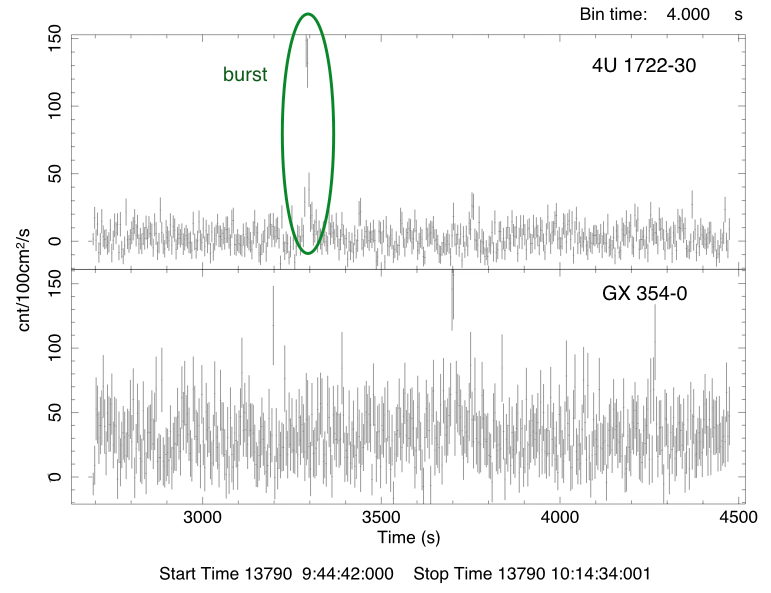 |
The new ligthcurves extraction tool of j_ima_iros provides the possibility to perform, along with the standard timing analysis, also an automatic search of bursting events (through the parameter LCR_doBurstSearch). Note that with ``bursting event'' we consider here a generic flux excursion, not necessarily a true X-ray or gamma-ray burst!. This feature is useful to enhance the scientific outcome of JEM-X, which can optimally detect X-ray bursts during continuous observations. However, this feature should be considered as experimental.
To examine an example of the automatic burst search, let's create a new SCW list containing only the SCW 041100230010, and call it burst.lst. This file will contain the line:
041100230010.001
We create the og_group for this SCW, and perform the analysis up to LCR step:
og_create idxSwg=burst.lst ogid=burst baseDir="./" instrument=JMX1
cd obs/burst
jemx_science_analysis startLevel="COR" endLevel="LCR" jemxNum=1 \
nChanBins=-1 LCR_useIROS=yes LCR_timeStep=4 LCR_doBurstSearch=yes \
IMA_burstImagesOut=yes
Here, we specified that we want to perform the analysis up to the LCR level, in two standard energy bands (nChanBins=-1), and that we want to extract the lightcurves with the j_ima_iros tool (LCR_useIROS=yes). Moreover, we are going to perform the automatic search for bursting events (LCR_doBurstSearch=yes; which is also the default value of this hidden parameter). Finally, IMA_burstImagesOut=yes will append the field of view images t the time of bursts to jemx1_sky_image.fits.
Once the analysis will be completed, you will find that the algorithm detected one bursting event in the FOV and time span by your SCW.
In this case, the source that was bursting is 4U 1722-30 and it was automatically recognized by a coordinate match with the general catalog sources. This can be seen in the source result file: jmx1_srcl_res.fits. The sources for which bursts are found have the value 512 for the column FLAG. The file jmx1_src_iros_lc.fits contains the light curves of all sources found in the FOV, including the results for the bursting source(s).
In the last two extensions of the lightcurve file jmx1_src_iros_lc.fits, you
will find the lightcurves for 4U 1722-30 extracted in the two
energy bands (See Fig. ![[*]](crossref.png) ).
).
The burst search is performed by default and can be disabled by setting
the parameter burstImagesOut=no. However, by default images of
the field of view at the time of the burst are not produced.
If a burst is detected, it is however important to check that the
source producing the burst is indeed well identified in the image;
the user should set the parameter IMA_burstImagesOut=yes
as in the example here.
These images are appended to jemx_sky_image.fits
and will be characterized by a relatively short exposure (some seconds).
The parameters RTSTART and RTSTOP will pinpoint the
times at which images are extracted to evidence the burst.
This is the way to know at which time the burst is detected.
For instance, in the above example, the extensions of jmx1_sky_ima.fits
have the parameters of table ![[*]](crossref.png) . The first four extensions
contain the variance and reconstructed images of the full science window for the two
energy bands selected by the user;
the last four of the time in which a burst was detected. These informations are also
logged after the string ``BurstImaJ1'' in the OSA log file.
. The first four extensions
contain the variance and reconstructed images of the full science window for the two
energy bands selected by the user;
the last four of the time in which a burst was detected. These informations are also
logged after the string ``BurstImaJ1'' in the OSA log file.